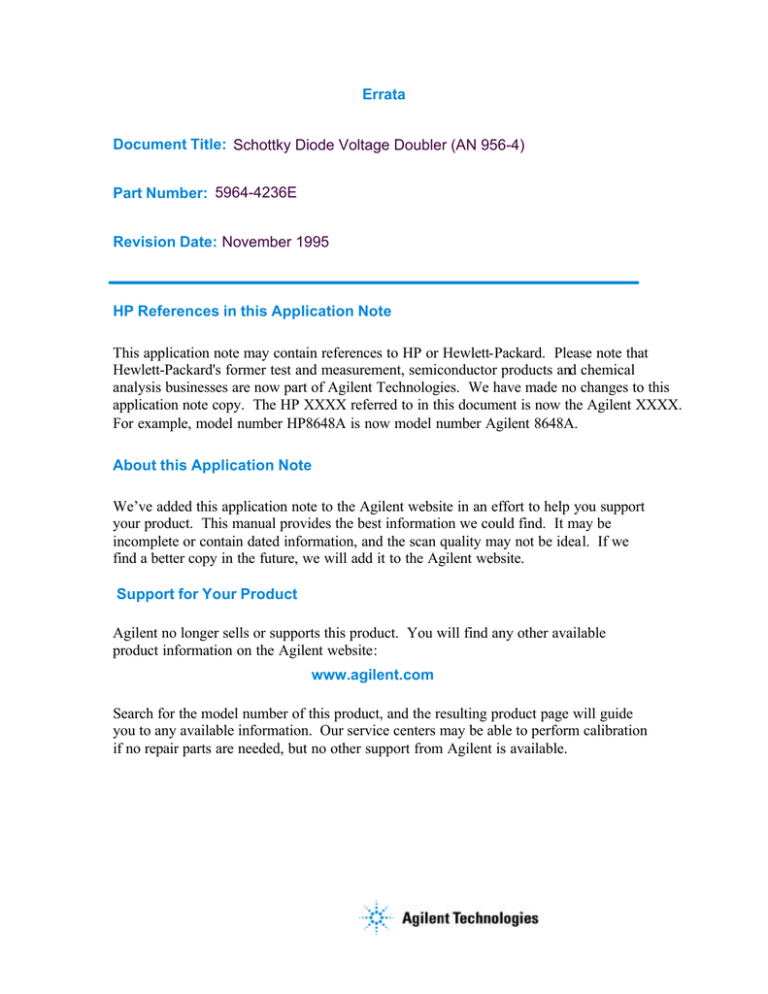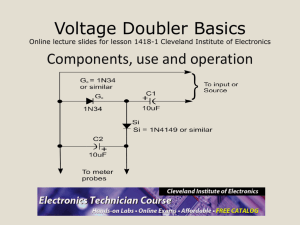AN 956-4: Schottky Diode Voltage Doubler
advertisement

Errata Document Title: Schottky Diode Voltage Doubler (AN 956-4) Part Number: 5964-4236E Revision Date: November 1995 HP References in this Application Note This application note may contain references to HP or Hewlett-Packard. Please note that Hewlett-Packard's former test and measurement, semiconductor products and chemical analysis businesses are now part of Agilent Technologies. We have made no changes to this application note copy. The HP XXXX referred to in this document is now the Agilent XXXX. For example, model number HP8648A is now model number Agilent 8648A. About this Application Note We’ve added this application note to the Agilent website in an effort to help you support your product. This manual provides the best information we could find. It may be incomplete or contain dated information, and the scan quality may not be ideal. If we find a better copy in the future, we will add it to the Agilent website. Support for Your Product Agilent no longer sells or supports this product. You will find any other available product information on the Agilent website: www.agilent.com Search for the model number of this product, and the resulting product page will guide you to any available information. Our service centers may be able to perform calibration if no repair parts are needed, but no other support from Agilent is available. hH Schottky Diode Voltage Doubler Application Note 956-4 Circuit Description Figure 1 shows a simple voltage doubler circuit that was assembled in HP Package 60 and tested at 2 GHz. In this version of the doubler, opposite polarity chips are needed. The shunt chip is a 5082-0009 detector. The series chip is a 5082-0023 mixer. Interchanging the chips does not affect performance. The circuit may also be assembled using packaged diodes, in which case the polarity requirements may be met by physically reversing the packages, thus eliminating the need for opposite polarity diodes. doubler output is seen to be the sum of the detected voltage from two diodes in both cases. 10 DOUBLER Note that the two diodes are in shunt at R.F. so the impedance is halved. Impedance matching circuits will thus be easier to design. 1 VOLTAGE OUT, V Diode detectors may be combined in various ways[1] to produce higher output voltages than would be produced by a single diode. This note describes a microwave circuit that combines the detected output of two diodes to produce a detector with double the usual voltage sensitivity. Performance Measured performance of the voltage doubler at 2 GHz compared to a single diode is shown in Figure 2. A triple stub tuner was used to match the detectors at each input level. Figure 3 shows similar data with the tuner adjusted at -30 dBm and fixed at that position. The SINGLE DIODE DETECTOR .1 .01 .001 .0001 -50 -40 -30 -20 -10 0 POWER IN, dBm 10 20 Figure 2. Voltage Doubler Tuned at Each Power Level. 10 DOUBLER 1 VOLTAGE OUT, V Introduction SINGLE DIODE DETECTOR .1 .01 .001 .0001 -50 -40 -30 -20 -10 0 POWER IN, dBm 10 Figure 3. Voltage Doubler Tuned at –30 dBm. Figure 1. Voltage Doubler Schematic. 20 hH is the input sine wave plus a d.c. The voltage doubler is a combina- component equal to the peak tion of a clamper, the shunt diode, voltage. The detected voltage is then the peak-to-peak voltage of and a detector. Diode clamping the sine wave, double the peak action has been discussed in amplitude detected by a single Hewlett-Packard Application diode. Note 942. The input sine wave, symmetrical about zero volts is raised by the clamper so that the Reference minimum voltage is zero. The 1. E. Angelo, Jr., “Electronic input to the series detector diode Circuits”, McGraw-Hill, 1958. How It Works For technical assistance or the location of your nearest Hewlett-Packard sales office, distributor or representative call: Americas/Canada: 1-800-235-0312 or 408-654-8675 Far East/Australasia: (65) 290-6305 Japan: (81 3) 3331-6111 Europe: Call your local HP sales office listed in your telephone directory. Ask for a Components representative. Data Subject to Change Copyright © 1995 Hewlett-Packard Co. Printed in U.S.A. 5964-4236E (11/95)



